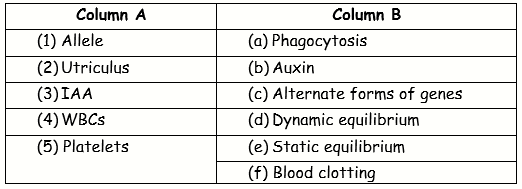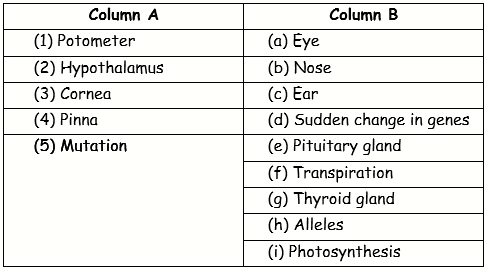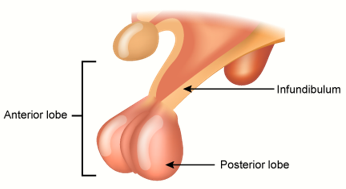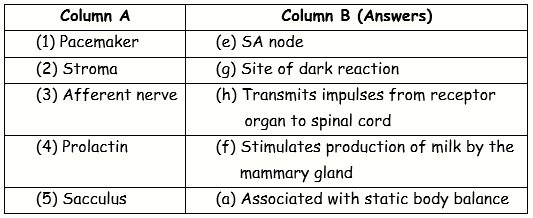Name the following:
- Exchange of chromatid parts between the maternal and paternal chromatids of a pair of homologous chromosomes during meiosis [1 M]
- Process of uptake of mineral ions against the concentration gradient using energy from the cell [1 M]
- Process of conversion of ADP to ATP during photosynthesis [1 M]
- Phase of the cardiac cycle in which the auricles contract [1 M]
- Structural and functional unit of the kidney [1 M]
- Fluid which provides protection and nourishment to the cells of the brain [1 M]
- The layer of the eyeball that provides nourishment to the eye. [1 M]
Choose the correct answer from each of the four options given below:
1. The mineral ion needed for the formation of a blood clot is [1 M]
A. Potassium
B. Sodium
C. Calcium
D. Iron
2. A plant cell may burst when [1 M]
A. Turgor pressure equalises wall pressure
B. Turgor pressure exceeds wall pressure
C. Wall pressure exceeds turgor pressure
D. None of the above
3. Chromosomes get aligned at the centre of the cell during [1 M]
A. Metaphase
B. Anaphase
C. Prophase
D. Telophase
4. Cretinism and myxoedema are due to [1 M]
A. Hypersecretion of thyroxine
B. Hypersecretion of growth hormone
C. Hyposecretion of thyroxine
D. Hyposecretion of growth hormone
5. After mitotic cell division, a female human cell will have [1 M]
A. 44 + XX chromosomes
B. 44 + XY chromosomes
C. 22 + X chromosomes
D. 22 + Y chromosomes
6. A pulse wave is mainly caused by the [1 M]
A. Systole of atria
B. Diastole of atria
C. Systole of the left ventricle
D. Systole of the right ventricle
7. A plant is kept in a dark cupboard for 48 hours before conducting any experiment on photosynthesis to [1 M]
A. Remove starch from the plant
B. Ensure that starch is not translocated from the leaves
C. Remove chlorophyll from the leaf of the plant
D. Remove starch from the experimental leaf
8. A reflex arc in man is best described as the movement of stimuli from [1 M]
A. Receptor cell, sensory neuron, relaying neuron, effector muscles
B. Receptor cell, efferent nerve, relaying neuron, muscles of the body
C. Receptor cell, spinal cord, motor neuron, relaying neuron
D. Receptor cell, synapse, motor neuron, relaying neuron
In each set of terms given below, there is an odd one and cannot be grouped in the same category to which the others belong. Identify the odd term in each set and name the category to which the remaining belong.
- Cell wall, large vacuole, plastid, centrosome [1 M]
- Thymine, cytosine, adenine, pepsin [1 M]
- Cortisone, somatotropin, adrenocorticotropic hormone, vasopressin [1 M]
- Urethra, uterus, urinary bladder, ureter [1 M]
- Transpiration, photosynthesis, phagocytosis, guttation [1 M]
- Sneezing, coughing, blinking, typing [1 M]
- Malleus, pinna, incus, stapes [1 M]
- Insulin, adrenaline, pepsin, thyroxine [1 M]
State the exact location of the following structures:
- Centromere [1 M]
- Chordae tendineae [1 M]
- Thylakoids [1 M]
- Pulmonary semilunar valve [1 M]
- Corpus callosum [1 M]
- Guard cells [1 M]
- Thyroid gland [1 M]
- Organ of Corti [1 M]
State the main function of the following:
- Cerebrospinal fluid [1 M]
- Lenticels [1 M]
- Ureter [1 M]
- Chordae tendineae [1 M]
- Vitreous humour [1 M]
- Medulla oblongata [1 M]
- Beta cells of the pancreas [1 M]
Differentiate between the following pairs on the basis of what is mentioned within brackets:
1. Rod cells and cone cells (pigment) [1 M]
2. Ureter and urethra (function) [1 M]
3. Diffusion and osmosis (definition) [1 M]
4. Diabetes mellitus and diabetes insipidus (reason/cause) [1 M]
5. ATP and AIDS (expand the abbreviations) [1 M]
6. Turgor pressure and wall pressure (explain) [1 M]
7. Leaf and liver (form in which glucose is stored) [1 M]
8. Bowman's capsule and Malpighian capsule (parts included) [1 M]
Give the biological/technical term for the following:
1. Removal of nitrogenous wastes from the body [1 M]
2. Process of maintaining water and salt balance in the blood. [1 M]
3. Process by which white blood cells engulf bacteria [1 M]
4. Solution in which the relative concentration of water molecules and the solute on either side of the cell membrane is the same [1 M]
5. Permanently open structures seen on the bark of an old woody stem [1 M]
6. Squeezing of WBCs through the walls of the capillaries into the tissue [1 M]
7. Defect of the eye where the eye lens loses flexibility resulting in long sightedness in the elderly [1 M]
Explain the following terms:
1. Reflex action [1 M]
2. Photophosphorylation [1 M]
3. Plasmolysis [1 M]
4. Turgor pressure [1 M]
5. Guttation [1 M]
6. Pulse [1 M]
7. Diapedesis [1 M]
8. Synapse [1 M]
Give scientific reasons for the following statements:
1. Injury to the medulla oblongata leads to death. [1 M]
2. Blood flows in the arteries in spurts and is under pressure. [1 M]
3. There is frequent urination in winter than in summer. [1 M]
4. Balsam plants wilt during mid-day even if the soil is well watered. [1 M]
5. Wooden frames of doors get jammed during the monsoon season. [1 M]
6. Throat infection can lead to ear infection. [1 M]
7. The wall of the ventricle is thicker than that of the auricle. [1 M]
8. A person walks unsteadily when drunk. [1 M]
9. The pituitary gland is known as the ‘master gland’. [1 M]
Answer briefly:
- What is the difference between chromatin fibre and chromosome? [1 M]
- When are the sounds "LUBB" and "DUP" produced respectively during heart beat? [1 M]
- Name the part of the human brain which is associated with the following: [1 M]
(a) Seat of memory (b) Coordinates muscular activity - If you sprinkle some common salt on grass growing on a lawn, it is killed at that spot. Why? [1 M]
- Mention any two adaptations found in plants to favour the process of photosynthesis. [1 M]
- Why does one feel blinded for a short while on coming out of a dark room? [1 M]
- Why is iodine as a nutrient, important to our body? [1 M]
Match the items in Column ‘A’ with those which are most appropriate in Column ‘B’. Rewrite the matching pairs.
1. [5 M]
2. [5 M]
3. [5 M]
4. [5 M]
5. [5 M]
Diagram-based questions:
1. Diagram depicting a defect of the human eye. You may be asked to identify the defect, list its causes and state the corrective measures. [5 M]
Example:
Given below is a diagram depicting a defect of the human eye, study the same and then answer the questions that follow:
- Name the defect shown in the diagram.
- What are the two possible reasons for this defect?
- Name the type of lens used to correct this defect.
- With the help of a diagram, show how the defect shown above is rectified using a suitable lens.
2. Diagrammatic representation of a part of the cross section of the root in the root hair zone. You may be asked to label the parts, list and define the processes taking place in this zone. [5 M]
Example:
The figure given below is a diagrammatic representation of a part of the cross section of the root in the root hair zone. Study the same and then answer the questions that follow:
- Name the parts indicated by the guidelines 1 to 4.
- Which is the process that enables the passage of water from the soil into the root hair?
- Name the pressure that is responsible for the movement of water in the direction indicated by the arrows. Define it.
- Due to an excess of this pressure, drops of water are sometimes found along the leaf margins of some plants in the early morning. What is the phenomenon called?
- Draw a well-labelled diagram of the root hair cell as it would appear if an excess of fertiliser is added to the soil close to it.
3. Outline of the human body showing the important glands. You may be asked to identify the glands, list the hormones secreted by these glands and the disorders caused by the deficiency of these hormones. [5 M]
Example:
The diagram given below represents an endocrine gland in the human body. Study the diagram and answer the following questions:
- Identify the endocrine gland. Where is it located?
- Why is the above gland referred to as the ‘master gland’?
- Name the hormone whose deficiency causes diabetes insipidus. How does this disorder differ from diabetes mellitus?
- Explain the term ‘hormone’.
What is the role of tropic hormones in the human body? - Which lobe of the above gland secretes
- Oxytocin
- ACTH
- Growth hormone
4. Diagram of Ganong’s photometer. You may be asked to identify the apparatus, its working, use and limitations. [5 M]
Example:
The diagram given below demonstrates a particular process in plants. Study the same and answer the questions that follow:
- Name the apparatus.
- Which phenomenon is demonstrated by this apparatus? Explain the phenomenon.
- State two limitations of using this apparatus.
- What is the importance of the air bubble in the experiment?
- Name the structures in a plant through which the above process takes place.
5. Diagrams showing the experiments on photosynthesis in green plants. You may be asked to identify and define the process, chemical equation for photosynthesis and the effect of alteration in the factors affecting photosynthesis. [5 M]
Example:
A potted plant with variegated leaves was taken in order to prove a factor necessary for photosynthesis. The potted plant was kept in the dark for 24 hours and then placed in bright sunlight for a few hours. Observe the diagram and answer the questions
- What aspect of photosynthesis is being tested in the above diagram?
- Represent the process of photosynthesis in the form of a balanced equation.
- Why was the plant kept in the dark before beginning the experiment?
- What will be the result of the starch test performed on leaf ‘A’ shown in the diagram? Given an example of a plant with variegated leaves.
- Draw a neat and labelled diagram of a chloroplast.
6. Diagrams showing the experiments on transpiration in plants. You may be asked to identify and define the process, its significance, technical aspects of the experiment and adaptations in plants to minimise loss of water through transpiration. [5 M]
Example:
The diagram below represents a process in plants. The setup was placed in bright sunlight. Answer the following questions:
- Name the physiological process depicted in the diagram.
Why was oil added to the water? - When placed in bright sunlight for four hours, what do you observe with regard to the initial and final weight of the plant?
Give a suitable reason for your answer. - What happens to the level of water when this setup is placed in
1. Humid conditions
2. Windy conditions - Mention any three adaptations found in plants to overcome the process mentioned in (i).
- Explain the term ‘Guttation’.
7. Diagram showing the cross section of blood vessels. You may be asked to identify the blood vessels, their functions, type of blood that flows in each of these vessels and the structural differences between the blood vessels. [5 M]
Example:
The diagrams given below are cross sections of blood vessels:
- Identify the blood vessels A, B and C.
- Name the parts labelled 1 to 3.
- Name the type of blood that flows through A.
- Mention one structural difference between A and B.
- In which of the above vessels does the exchange of gases actually take place?
8. Diagrammatic/schematic representation of the human heart. You may be asked to label the parts, list details about their structure and functions and the process of blood circulation. [5 M]
Example:
The diagram below represents the human heart in one phase of its function. Study the diagram carefully and answer the questions that follow:
- Name the phase.
- Which part of the heart is contracting in this phase? Give a reason to support your answer.
- Name the parts labelled 1 to 4.
- What type of blood flows through ‘2’?
- State the function of the part numbered ‘5’.
- Name the membrane that covers the heart.
9. Diagram showing the section of the spinal cord. You may be asked to label the parts and list their functions. There might be a question based on synapse. [5M]
Example:
The diagram given below shows the internal structure of a spinal cord depicting a phenomenon. Study the diagram and answer the questions:
- Name the phenomenon that is depicted in the diagram. Define the phenomenon.
- Give the technical term for the point of contact between two nerve cells.
- Name the parts numbered 1, 2 and 3.
- How does the arrangement of neurons in the spinal cord differ from that of the brain?
- Mention two ways by which the spinal cord is protected in our body.
10. Diagram representing a stage during mitotic/meiotic cell division. You may be asked to identify the stage, the chromosome number at the given stage and details about the stages which follow the given stage. [5 M]
Example:
Study the diagram given below which represents a stage during mitotic cell division and answer the questions that follow:
- Identify the stage giving suitable reasons.
- Name the parts numbered 1 and 2.
- What is the technical term for the division of the nucleus?
- Mention the stage that comes before the stage shown in the diagram. Draw a neat and labelled diagram of the stage mentioned.
- Which is the cell division that results in half the number of chromosomes in daughter cells?
Explore more Biology Sample papers and Solutions
-
Specimen Papers for ICSE Class 10 Biology 2024 Examination
-
Sample Papers For ICSE Class 10 Biology 2024 #1
- Sample Papers For ICSE Class 10 Biology 2024 #2
- Sample Papers For ICSE Class 10 Biology 2024 #3
- Sample Papers For ICSE Class 10 Biology 2024 #4
- Sample Papers For ICSE Class 10 Biology 2024 #5
- Sample Papers For ICSE Class 10 Biology 2024 #6
- Sample Papers For ICSE Class 10 Biology 2024 #7
- Sample Papers For ICSE Class 10 Biology 2024 #8
- Sample Papers For ICSE Class 10 Biology 2024 #9
- Sample Papers For ICSE Class 10 Biology 2024 #10
Key Features of Study Materials for ICSE Class 10 Biology:
- Easy to understand
- Prepared by subject experts
- Designed according to the latest ICSE syllabus
- Helpful when doing homework
- ‘Ask a Doubt’ facility
- Helpful for quick revision
- Significantly improve your scores
































